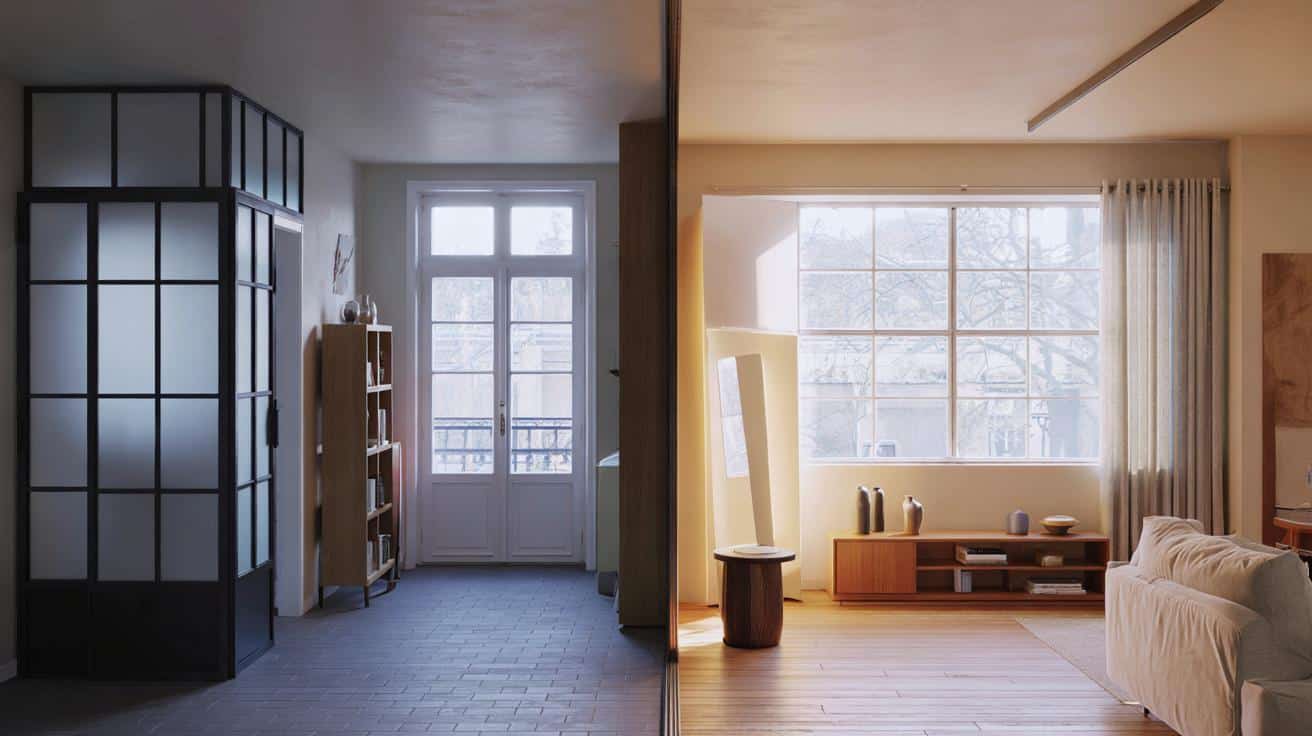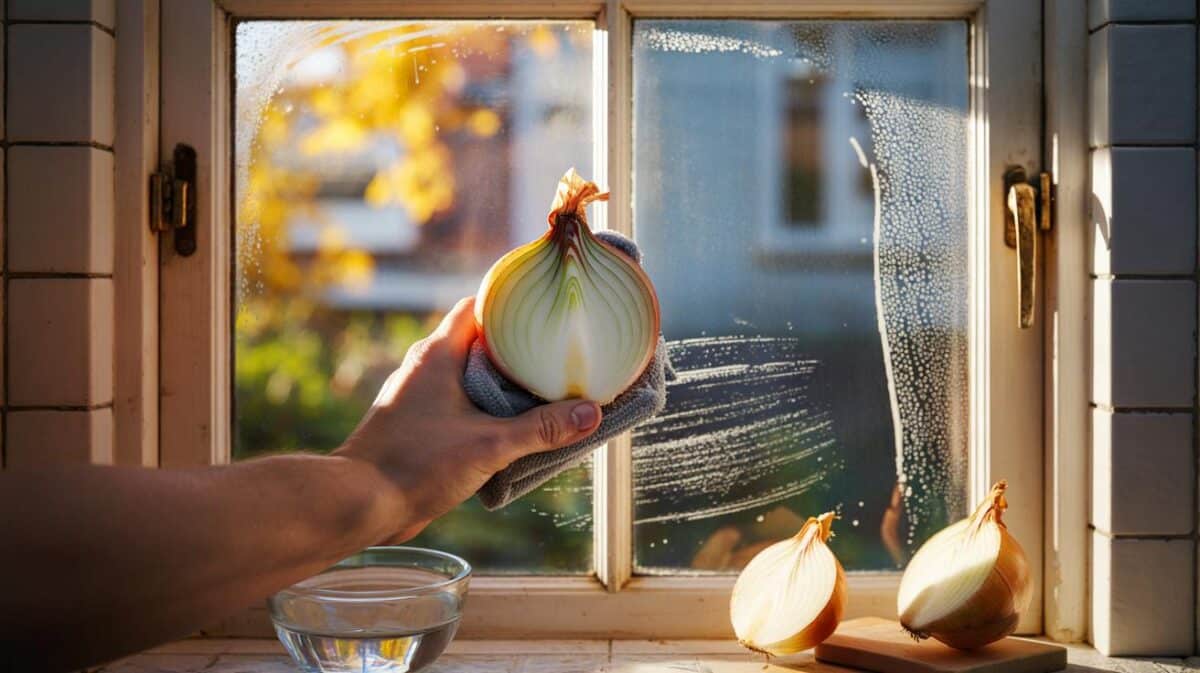Calm, warmth and a gentle glow rise above harder visual tricks.
Across France, designers are quietly retiring the factory-style glass partition and chasing softer daylight instead. You see it in show flats, boutique hotels and family homes: fewer black grids, more open sightlines, fewer barriers. The aim is simple. Let light travel. Let rooms breathe. Make daily life calmer through smart design rather than icon pieces.
The end of an era: why the atelier look no longer charms
The steel-framed screen once felt bold. Social feeds filled with it. Builders made it a default answer. It is now everywhere.
From unique to uniform
When a feature turns up in hallways, kitchens and ensuite doors all at once, it stops feeling special. Repetition dulls surprise. A black grid reads as a kit, not a considered choice, especially in compact flats where every line counts.
Light is a resource. Lines that slice it up change how you live, not just how a photo looks.
Light flow myths
A glazed partition looks bright in a showroom. In a real plan, position and orientation govern results. Dark muntins create micro-shadows. Frosted panes mute daylight. Glass still blocks air movement, so one room bakes while the next stays chilly.
In north-facing rooms, grids can rob precious luminance. In low sun, reflections bounce into eyes rather than onto worktops. The effect feels busy, not calm.
Chilly looks, broken sightlines
Autumn and winter need softness. Black steel cuts horizons and cools palettes. It introduces visual noise near skirting height and eye level. Unless detailing is flawless, the frame reads as a barrier, not a bridge.
The new clarity: natural light without the grid
Designers switching focus in 2025 talk about daylight as a movement rather than a point. That means bigger apertures, slimmer profiles and fewer obstacles.
Bigger openings, slimmer frames
Sliding doors with pocket tracks erase door swings and reveal full wall widths. Oversized windows with minimal mullions push light deeper into plans. Lightweight folding screens flex with the day, not against it.
- Replace a 1.2 m doorway with a 2.4 m pocket pair to extend sightlines.
- Choose frames under 30 mm to cut shadow bands across floors.
- Use clear, low-iron glass where privacy is not an issue to lift clarity.
Materials and colours that lift daylight
Warm pale woods, textured linens and matte ceramics amplify soft light. They diffuse glare and remove the cold edge many associate with industrial interiors.
Wall colours in cream, clay, sage and terracotta carry light without sparkle. They sit close to natural materials, so rooms feel grounded during darker months.
Matte, textured and pale finishes turn small windows into calm light engines.
How designers redraw rooms to pull light deeper
Mirrors move. They sit close to windows or at the end of corridors to bounce light around corners. Furniture drops in height so sightlines stay clear. Open shelves replace closed blocks to let light filter through objects.
- Mirror panels near reveals extend daylight by one to two metres into a plan.
- Low sofas and credenzas stop light getting trapped at window height.
- Sheer curtains in linen or cotton filter hard contrasts and add privacy.
Practical switch: from panes to plans
Clever replacements that keep rooms bright
You do not need heavy work to gain clarity. Think movable, breathable and soft-edged. Cane screens, timber slat panels and glazed pocket doors mark areas but let light pass.
| Solution | Typical cost (installed) | Estimated light gain* | Privacy | Notes |
|---|---|---|---|---|
| Pocket sliding doors, clear glass | €1,500–€3,800 | 20–35% vs a standard swing door | Low–medium | Opens full width; add sheers for evening |
| Timber slat (claustra) divider | €400–€1,600 | 15–25% vs solid half-wall | Medium | Controls views; warms palette |
| Wide opening with no door (arched or straight) | €900–€2,200 | 25–40% vs narrow opening | Low | Best for living–kitchen flow |
| Mirrors placed within 1 m of a window | €120–€600 | 10–20% perceived increase | n/a | Use quality glass to avoid distortion |
*Perceived daytime increase in average room luminance, based on plan depth and paint reflectance.
Quick wins you can try this weekend
- Swap high-back armchairs for low-profile seating to free the window line.
- Move bookcases off external walls to stop daylight absorption.
- Layer sheers and heavier curtains: sheers by day, lined drapes by night.
- Choose warm white bulbs (2700–3000 K) to knit artificial and natural light.
- Use matte finishes on big surfaces; keep gloss for small accents only.
What the pros are installing right now
In bedrooms, designers pick low headboards and double curtain layers: linen for glow, gauze for softness. In living rooms, they group clear glass vases to scatter light and stick to low furniture so light crosses the space. In kitchens, open shelves and exposed ceramics turn early sun into a simple display.
Retailers have caught up. Autumn lines from IKEA, Maisons du Monde and Zara Home lean into pale woods, woven fibres and soft fabrics that pair well with large openings and matte walls. Price points vary, but the focus is the same: lift luminance, reduce clutter, keep warmth.
Does grid-free mean less comfort? manage the trade-offs
Glare, heat and privacy
Bigger panes can glare in low winter sun. Solar-control glass with a g-value around 0.4–0.6 cuts harsh gain. A slim external awning or a sheer curtain handles the rest. Heat loss is a concern in older frames. Modern double glazing with low‑e coatings and warm-edge spacers reduces that risk. Privacy still matters. Sheers, cane, and layered blinds protect views without blocking light.
- Specify U-values at or below 1.3 W/m²K for comfort in colder regions.
- Add acoustic seals to pocket doors if noise transfer worries you.
- Place task lamps near work areas so you do not chase brightness with overhead glare.
A simple daylight simulation you can copy
Take a 3 m × 5 m living space with a 2.4 m ceiling. It has a 1.5 m × 1.2 m window and a narrow 0.9 m internal door. Paint is mid-white with 70% reflectance. Replace the door with a 2.4 m pocket pair glazed in clear safety glass and widen the window to a 2.4 m sliding unit with slim frames. Midday measurements under bright overcast rise from roughly 160 lux at the room centre to about 220 lux. That is a perceived uplift of around 35%, enough to change how the space feels and how long you delay switching on lights.
You do not need more fixtures. You need fewer obstacles and smarter surfaces.
Why people are changing: light as everyday wellbeing
This shift is not a chase for a new badge. It answers daily habits. Families want rooms that calm busy mornings and soften long evenings. They want light that supports work, reading and meals without a hard edge. They want fewer visual rules and more room for personal pieces. Natural materials, generous openings and flexible layers do that without shouting.
Thinking further, tie light choices to energy and money. A brighter plan lets you drop daytime lighting hours. A better U-value lowers heating demand. A pocket door frees wall space for storage so you keep surfaces tidy. These gains stack. They raise comfort in small steps rather than relying on a single showpiece.








